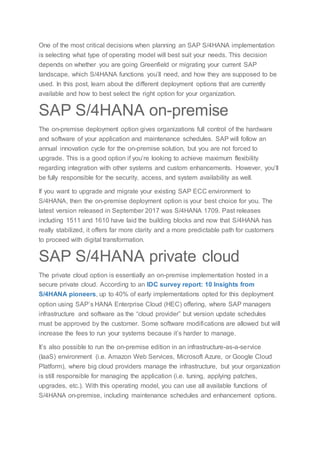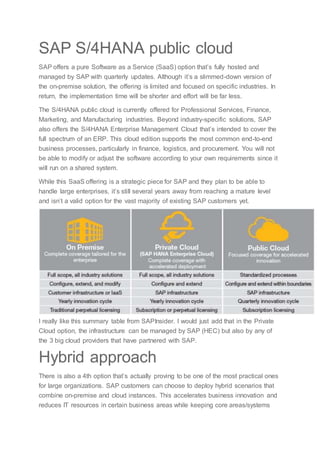Sap deployment
- 1. One of the most critical decisions when planning an SAP S/4HANA implementation is selecting what type of operating model will best suit your needs. This decision depends on whether you are going Greenfield or migrating your current SAP landscape, which S/4HANA functions you’ll need, and how they are supposed to be used. In this post, learn about the different deployment options that are currently available and how to best select the right option for your organization. SAP S/4HANA on-premise The on-premise deployment option gives organizations full control of the hardware and software of your application and maintenance schedules. SAP will follow an annual innovation cycle for the on-premise solution, but you are not forced to upgrade. This is a good option if you’re looking to achieve maximum flexibility regarding integration with other systems and custom enhancements. However, you’ll be fully responsible for the security, access, and system availability as well. If you want to upgrade and migrate your existing SAP ECC environment to S/4HANA, then the on-premise deployment option is your best choice for you. The latest version released in September 2017 was S/4HANA 1709. Past releases including 1511 and 1610 have laid the building blocks and now that S/4HANA has really stabilized, it offers far more clarity and a more predictable path for customers to proceed with digital transformation. SAP S/4HANA private cloud The private cloud option is essentially an on-premise implementation hosted in a secure private cloud. According to an IDC survey report: 10 Insights from S/4HANA pioneers, up to 40% of early implementations opted for this deployment option using SAP’s HANA Enterprise Cloud (HEC) offering, where SAP managers infrastructure and software as the “cloud provider” but version update schedules must be approved by the customer. Some software modifications are allowed but will increase the fees to run your systems because it’s harder to manage. It’s also possible to run the on-premise edition in an infrastructure-as-a-service (IaaS) environment (i.e. Amazon Web Services, Microsoft Azure, or Google Cloud Platform), where big cloud providers manage the infrastructure, but your organization is still responsible for managing the application (i.e. tuning, applying patches, upgrades, etc.). With this operating model, you can use all available functions of S/4HANA on-premise, including maintenance schedules and enhancement options.
- 2. SAP S/4HANA public cloud SAP offers a pure Software as a Service (SaaS) option that’s fully hosted and managed by SAP with quarterly updates. Although it’s a slimmed-down version of the on-premise solution, the offering is limited and focused on specific industries. In return, the implementation time will be shorter and effort will be far less. The S/4HANA public cloud is currently offered for Professional Services, Finance, Marketing, and Manufacturing industries. Beyond industry-specific solutions, SAP also offers the S/4HANA Enterprise Management Cloud that’s intended to cover the full spectrum of an ERP. This cloud edition supports the most common end-to-end business processes, particularly in finance, logistics, and procurement. You will not be able to modify or adjust the software according to your own requirements since it will run on a shared system. While this SaaS offering is a strategic piece for SAP and they plan to be able to handle large enterprises, it’s still several years away from reaching a mature level and isn’t a valid option for the vast majority of existing SAP customers yet. I really like this summary table from SAPInsider. I would just add that in the Private Cloud option, the infrastructure can be managed by SAP (HEC) but also by any of the 3 big cloud providers that have partnered with SAP. Hybrid approach There is also a 4th option that’s actually proving to be one of the most practical ones for large organizations. SAP customers can choose to deploy hybrid scenarios that combine on-premise and cloud instances. This accelerates business innovation and reduces IT resources in certain business areas while keeping core areas/systems
- 3. robust and customizable. Companies can opt for a hybrid cloud model that combines public cloud and private cloud deployments or choose a full hybrid operating model where some business scenarios are handled on-premise and some are handled in the cloud. This operating model allows you to combine the best of both worlds. You can operate core areas of your enterprise like finance, sales, inventory, and manufacturing on-premise, and other enterprise areas like CRM in the cloud because common industry standards are sufficient, or data that is less sensitive can be stored in the cloud. Hybrid scenarios might make sense based on your organizational structures as well. You might want to run your headquarters on- premise and your subsidiaries in the cloud. For more information on using the Hybrid approach, check out this webinar to hear how Scientific Drilling used simple and flexible solutions to ease their migration, and support ongoing data upload needs for their Hybrid S/4HANA implementation.



